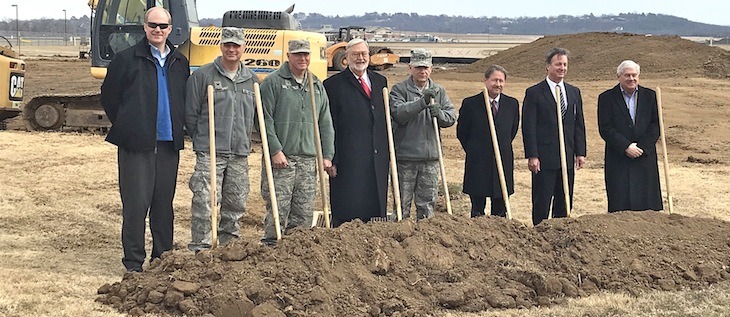188th Wing announces new $14.2 million Razorback Operations Center
by February 13, 2018 6:11 pm 1,973 views

188th members and community officials gathered Feb. 13 for the formal groundbreaking on the Razorback Operation Center at Ebbing Air National Guard Base in Fort Smith.
The ROC has broken ground.
On Tuesday (Feb. 13), the 188th Wing of the Arkansas Air National Guard announced the Razorback Operation Center at a groundbreaking ceremony from Ebbing Air National Guard Base in Fort Smith. The center will conduct both training and active missions across the globe, and it will continue providing support domestically as it did recently with Hurricanes Harvey and Irma.
Construction of the ROC is expected to finish in 2020.
Saving for the ROC first showed up in the guard’s 2015 budget, though discussion of the need for it went back further to around 2013, according to 188th Commander Col. Robert Kinney.
“Everything in Washington and the Department of Defense works on two-year cycles like that, so if you’re going to go out and start a new facility, typically it’s a minimum of two years before you actually see the money in the budget for such an effort,” Kinney told Talk Business & Politics.
The 40,000-square foot, $14.2 million facility will be the first location in the country to house Remote Piloted Aircraft (RPA), Distributed Communications Ground System (DGS), and Targeting Intelligence Production Squadron (IS) missions under one roof. Kinney said the decision came about “in the 2013-2014 timeframe” out of a desire to find “new ways of doing business.”
“Part of it was budgetary in that you can save money by putting people in the same facility, but that wasn’t the only driver. With the similarity in mission sets, we thought it would be a very good idea to put them under one roof because most remotely piloted aircraft are flown at remotely piloted aircraft units. Most ISR is done at ISR units. What makes this unique is, we’ll put these disparate mission sets together that have similarities that typically are done in separate locations around the country and put them under one roof. That’s why we believe there are some as-yet-to-be-discovered synergies, efficiencies, and potentially new ways of doing business that people haven’t discovered yet,” Kinney said, adding that “you can’t put a price on one-on-one interaction, in person, in my mind.”
Kinney also expects the facility will help with recruiting efforts, stating that numbers already are on the uptick. “We’ve put some more recruiters out on the street, and with this mission set, we believe kids today want to get into these high-tech mission sets. They like the idea of analysis. They like the idea of working with computers and potentially using a joystick and those types of things. We think we’ve got the right mission for those individuals.”
Kinney said during the A-10 mission, many of the jobs were “maintenance” of the aircraft through duties like “sheet metal fabrication, avionics, taking care of the aircraft, and more of what you might term ‘blue-collar style jobs,’ which were great and are great.”
Kinney said many of the new jobs, including those housed in the ROC, will be more analytical “and use a little more of the book-type skills, if you will, and tend to be on the higher-tech end of the scale.” The shift has changed, in part, the type of recruit the 188th targets.
“We now have 100 percent state reimbursement for tuition at universities, and I think that that’s helped with recruiting. We do have some signing bonuses depending on the career field that you sign up for. Largely, some of the scores have changed, so for the intelligence career field, they are a little bit on the higher end, and that’s changed the type of person who comes through the door, but we still have a lot of different jobs for every person ultimately.”
Kinney called the Wing “part of the nation’s best,” adding that “we have proven such by coming so far in such a short period of time. The 188th’s transformation has been rapid considering that the last A-10s left Ebbing in June of 2014.” Since that time, he added, the Wing had to take on the three new mission sets, do “six years of hiring in six months,” and retrain 500 personnel in two years. The head count is around 850, but the base “is slotted for 1,000” full-time and drill status guardsmen, so there is “room to grow.”
Also Tuesday, Kinney praised the city of Fort Smith for its embrace of the 188th.
“Our guardsmen, our airmen, our citizen soldiers, we are part of the community. We do not live cloistered away on an airbase. We live in the community as part of the community. We have kids in the school district. We shop here. We live here. We pay taxes here. And I’m very proud to be part of this community. And I will tell you, having been around the Air National Guard and the Air Force now for nearly 28 years, this is the most special relationship that I have seen around the country. Very, very close-knit community, and this entire region supports the 188th.”
During the three-year period from the end of the A-10 mission, the 188th built a 3,500-square foot classified targeting facility, 5,000-square foot classified facility where combat operations take place 24/7/365, and renovated a 20,000-square foot operations facility where intelligence, surveillance, and reconnaissance (ISR) is conducted.
The 20,000-square foot facility will continue to serve the ISR team, while the 3,500-square foot building will be used for classroom training and support. As for the 5,000-square footer, it will be used “for much-needed administrative use,” according to Lt. Dylan Hollums with the 188th Wing Public Affairs.
